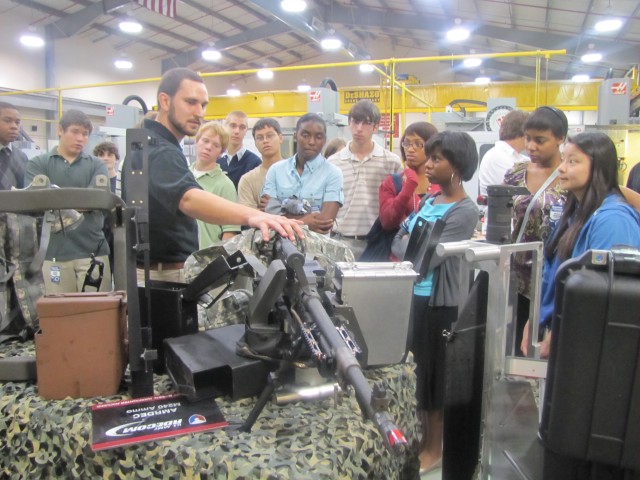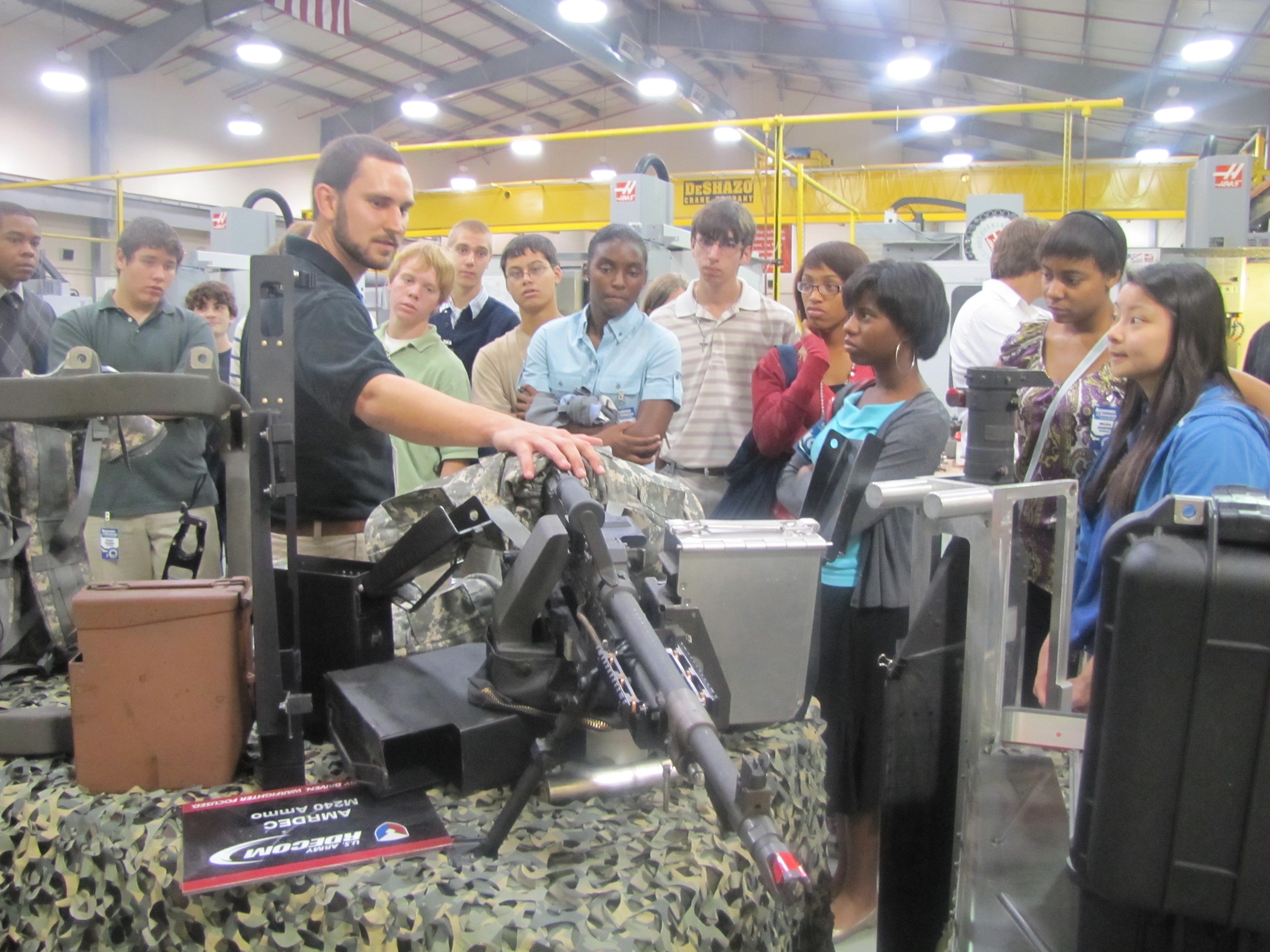
REDSTONE ARSENAL, Ala. -- In groups of about 15, high school students from across north Alabama got an up close view Sept. 29 of the helicopters, missiles and various hardware systems that have established Redstone Arsenal as a leader in engineering and development throughout the Army.
During the annual Adventures in Engineering Day, about 350 11th-graders spent the day immersing themselves into the role of an Arsenal engineer and experiencing some of the Arsenal's most interesting engineering feats, such as firing foam rocket interceptors at simulated targets, operating robots, checking out the workings of a Scud short-range ballistic missile system and viewing satellite simulations.
At one of the most popular stops of the day - the Aviation and Missile Research Development and Engineering Center's Prototype Integration Facility - students viewed several systems designed and prototyped to address specific issues faced by Soldiers in theater. Such products included a rifle mitt, ammunition canisters, a mounted AMRAAM missile on the HIMARS vehicle, maintenance tool kits, a new exhaust system for the Apache helicopter, a communication relay system for the Shadow unmanned aerial system and helicopters being equipped for the nation's border patrol mission.
"We deliver exactly what the customer wants," explained Greg Stuhr, a general engineer in the PIF's Technical Execution Group.
And that's exactly what teachers like Mark Maddox wants his students to see.
"This really gives the kids an idea of what engineering is about when you step into the real world," said Maddox, the engineering academy coordinator at Sparkman High School.
"It's one thing to read it in a textbook. But this lets them step inside to see what engineering and designing is all about."
There was a lot for the students to see at the PIF. While most products were examples of good news stories that made a difference in theater, students also saw a prototype of an improved personal effects locker developed with the input from the families of fallen Soldiers.
"This was not in our main line of work. But it shows how we bridge the gap from concept to prototype. It also reminds us who are customer is," PIF aviation special projects lead T.J. LaPointe told a group of students.
Also on the tour were future products, such as a video of the capabilities of the Iraqi Armed 407, now in development.
"It's so realistic, it gives you a real life picture of how it's going to work," PIF project engineer Christy Amos told a group of students. "Future capabilities videos like this show what technology we are now developing will be like."
The Iraqi Armed 407, which is slightly larger than a Kiowa, began as a commercial helicopter and is being transformed into a military aircraft by the PIF. Videos are used for all systems and tool kits throughout the Army to make it easier for Soldiers to operate, repair and maintain a wide variety of helicopter and missile systems.
LaPointe told students the PIF has used racecar technology to develop things like tear-off windshields and polished transmission gears for helicopters.
"We need that same technology used at a speedway here in our helicopters," he said. "We want to make sure our transmission gears don't wear out in a hot, sandy environment. Many of the systems we use are based on '60s and '70s technology that flew in Russia. Today's environment is much different."
At the Soldering and Circuit Lab, students saw technology that keeps systems operating and learned how Soldiers from the South Carolina National Guard test new prototypes.
"We want it rugged-ized," LaPointe said. "We don't want it to fail in theater. We want it to fail here so we can improve it and put out a better product."
The PIF mission is unique in that "we are 100 percent customer funded. We're a dynamic organization and we are always looking for the best bang for the buck ... We focus on rapid response for the war fighter," LaPointe told the students.
Seventy percent of PIF work involves aviation systems with the other 30 percent focused on vehicle and missile integration.
A lot of the PIF technologies are fairly simple, such as a new helicopter cable that shoots a protective flare and the two-handed mit sewn over the base of an Army helicopter rifle to keep hands from getting numb in the cold climates of Afghanistan.
"It might be something simple. But it's a big deal that saves lives," LaPointe said.
Many of the new technologies enhance or change mission capabilities, such as the new SLAMRAAM, which mounts M-16 AMRAAM missiles on the back of a HIMARS vehicle. The development takes HIMARS from being a tank blaster to also being able to shoot down "anything that flies," LaPointe said. "It's a game changer that can protect our Soldiers."
Students participating in Adventures in Engineering came from several area high schools, including Grissom, Sparkman, Fyffe, Randolph, Decatur, Madison County, Catholic and Hazel Green. Besides the PIF, students also visited the Space and Missile Defense Command, AMRDEC's Software Engineering Directorate, the Missile and Space Intelligence Center, the Missile Defense Agency and NASA's Marshall Space Flight Center. The day's activities were sponsored by the Air, Space and Missile Defense Association, National Defense Industrial Association and the Junior Achievement of Northern Alabama. The University of Alabama-Huntsville hosted the event.
Adventures in Engineering promotes science and engineering disciplines as a career choice, allowing high school students to observe what engineers do on a daily basis, providing them with hands-on knowledge and encouraging them to pursue a science profession in Huntsville.
At the end of the PIF tour, LaPointe knew exactly what to ask his students: "So, what have you seen here' You've seen some cool stuff haven't you' Do you want to be engineers' ... It's a great career."
For most of the students, engineering did seem like a pretty cool career choice.
Ryan Cole and Hayley Mills of the Limestone County Technical Center both considered the PIF tour one of the highlights of the day. They also enjoyed seeing enemy missiles being studied at MSIC.
"I thought all the different technologies were really interesting," Cole said. "I enjoy learning about a lot of different stuff."
Fellow technical center student Preston Carr agreed with them.
"I really liked seeing how they take missiles apart and they learn what's in them so they can understand what we need to do to defend against them," Carr said, referring to MSIC.
"I didn't realize there was so much out here," Cole added. "I knew the Arsenal had a big role in the nation's defense. But I had no idea what the role was or what it meant for all of us."

Social Sharing